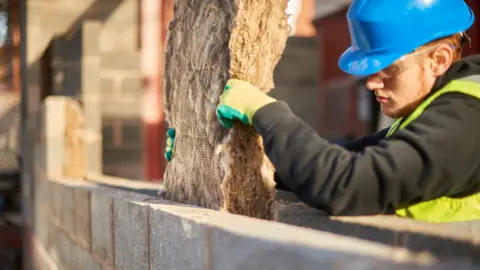Labour plans tougher energy efficiency rules for social homes


Raising Energy Efficiency Rules for Social Housing

Getty Images
The Plan to Cut Fuel Bills and Meet Climate Goals
- The energy secretary has announced plans to raise energy efficiency rules for social housing in order to cut fuel bills for tenants and meet climate goals.
- Speaking at Labour conference, Ed Miliband unveiled plans for all social homes in England to achieve an energy performance certificate (EPC) rating of at least C by 2030.
- The plan, which will be subject to a consultation later this year, widens an existing Labour pledge to apply the new rule to private landlords.
- A third of social homes, around 1.2 million, are currently rated D or below and will require new insulation, windows, and heating systems to come up to scratch.
Expanding the Requirements to Councils and Housing Associations
- The Conservatives originally planned to force all private landlords to reach the standard by 2028, but this was scrapped by Rishi Sunak last year, who argued the increased costs could push up rents.
- Labour promised to reverse this in its election manifesto, while giving private landlords a further two years to reach at least a C rating.
- Now the party has announced the requirement to reach level C by 2030 will also apply to councils and housing associations in England.
- In a speech to the conference in Liverpool, Miliband said the plan would lift a million people out of “fuel poverty” and showed “the difference a Labour government makes”.
- Currently, private properties in England and Wales need to reach at least level E to be rented out.
- Landlords have to pay for upgrades to reach this level, such as replacing boilers, improving insulation, and double-glazing windows, with costs capped at £3,500.
Retrofitting Requirements
- The EPC system, introduced in 2007, rates properties by energy efficiency, with the most efficient properties rated A and the least efficient G.
- Official statistics show efficiency is generally higher in the social rented sector, with around 70% of properties rated A-C in 2022, compared to 44% in private rentals.
- But that still leaves around 1.2 million social properties in England below a D rating, in addition to 2.6 million properties being rented privately.
- The National Housing Federation, which represents housing associations, has previously put the average cost of bringing a social housing property up to level C at between £3,000 and £4,000.
- Head of member relations Kevin Garvey said meeting Labour’s target would require housing associations to double the current pace of retrofitting homes, as well as having clear plans for homes that are harder to decarbonize.
- “Housing associations need a commitment to long-term funding from the government to ensure they have the resources they need,” he added.
Insulation Funding
- Labour has promised £13.2 billion in grants and low-interest loans over the next five years to help meet the 2030 deadline, with a target to upgrade five million homes.
- Although around double the total allocated by the previous Tory government, this total was scaled back ahead of the election from an initial plan to spend £60 billion over 10 years.
- The Times has reported that Labour is expected to consult on capping costs to landlords at around £10,000, the same level previously announced by the Conservatives to meet the 2028 deadline.
- Property firm Savills has previously estimated that landlords would be required to spend around £25 billion to bring private properties up to standard, assuming a £10,000 cap is put in place, with the biggest costs in upgrading older stock.
SDGs, Targets, and Indicators
1. Which SDGs are addressed or connected to the issues highlighted in the article?
- SDG 7: Affordable and Clean Energy
- SDG 11: Sustainable Cities and Communities
- SDG 13: Climate Action
- SDG 1: No Poverty
The issues highlighted in the article are connected to these SDGs because they involve improving energy efficiency in social housing, reducing fuel poverty, and addressing climate goals.
2. What specific targets under those SDGs can be identified based on the article’s content?
- Target 7.3: By 2030, double the global rate of improvement in energy efficiency
- Target 11.1: By 2030, ensure access for all to adequate, safe, and affordable housing and basic services and upgrade slums
- Target 13.2: Integrate climate change measures into national policies, strategies, and planning
- Target 1.2: By 2030, reduce at least by half the proportion of men, women, and children of all ages living in poverty in all its dimensions according to national definitions
The article discusses the plan to improve energy efficiency in social housing, provide affordable housing, and address climate change, which align with these targets.
3. Are there any indicators mentioned or implied in the article that can be used to measure progress towards the identified targets?
- Energy performance certificate (EPC) rating
- Proportion of social homes rated below a certain energy efficiency level
- Number of properties rented out at a certain energy efficiency level
- Costs of retrofitting homes to meet energy efficiency targets
- Amount of funding allocated for insulation and upgrades
The article mentions the EPC rating system, the number of social homes below a certain energy efficiency level, and the costs of retrofitting homes. These indicators can be used to measure progress towards the identified targets.
Table: SDGs, Targets, and Indicators
| SDGs | Targets | Indicators |
|---|---|---|
| SDG 7: Affordable and Clean Energy | Target 7.3: By 2030, double the global rate of improvement in energy efficiency | – Energy performance certificate (EPC) rating – Proportion of social homes rated below a certain energy efficiency level |
| SDG 11: Sustainable Cities and Communities | Target 11.1: By 2030, ensure access for all to adequate, safe, and affordable housing and basic services and upgrade slums | – Number of properties rented out at a certain energy efficiency level |
| SDG 13: Climate Action | Target 13.2: Integrate climate change measures into national policies, strategies, and planning | – Energy performance certificate (EPC) rating – Costs of retrofitting homes to meet energy efficiency targets – Amount of funding allocated for insulation and upgrades |
| SDG 1: No Poverty | Target 1.2: By 2030, reduce at least by half the proportion of men, women, and children of all ages living in poverty in all its dimensions according to national definitions | – Proportion of social homes rated below a certain energy efficiency level |
Source: bbc.com









